AUTO TRANS SSANGYONG NEW ACTYON SPORTS 2013 Service Manual
[x] Cancel search | Manufacturer: SSANGYONG, Model Year: 2013, Model line: NEW ACTYON SPORTS, Model: SSANGYONG NEW ACTYON SPORTS 2013Pages: 751, PDF Size: 72.63 MB
Page 47 of 751
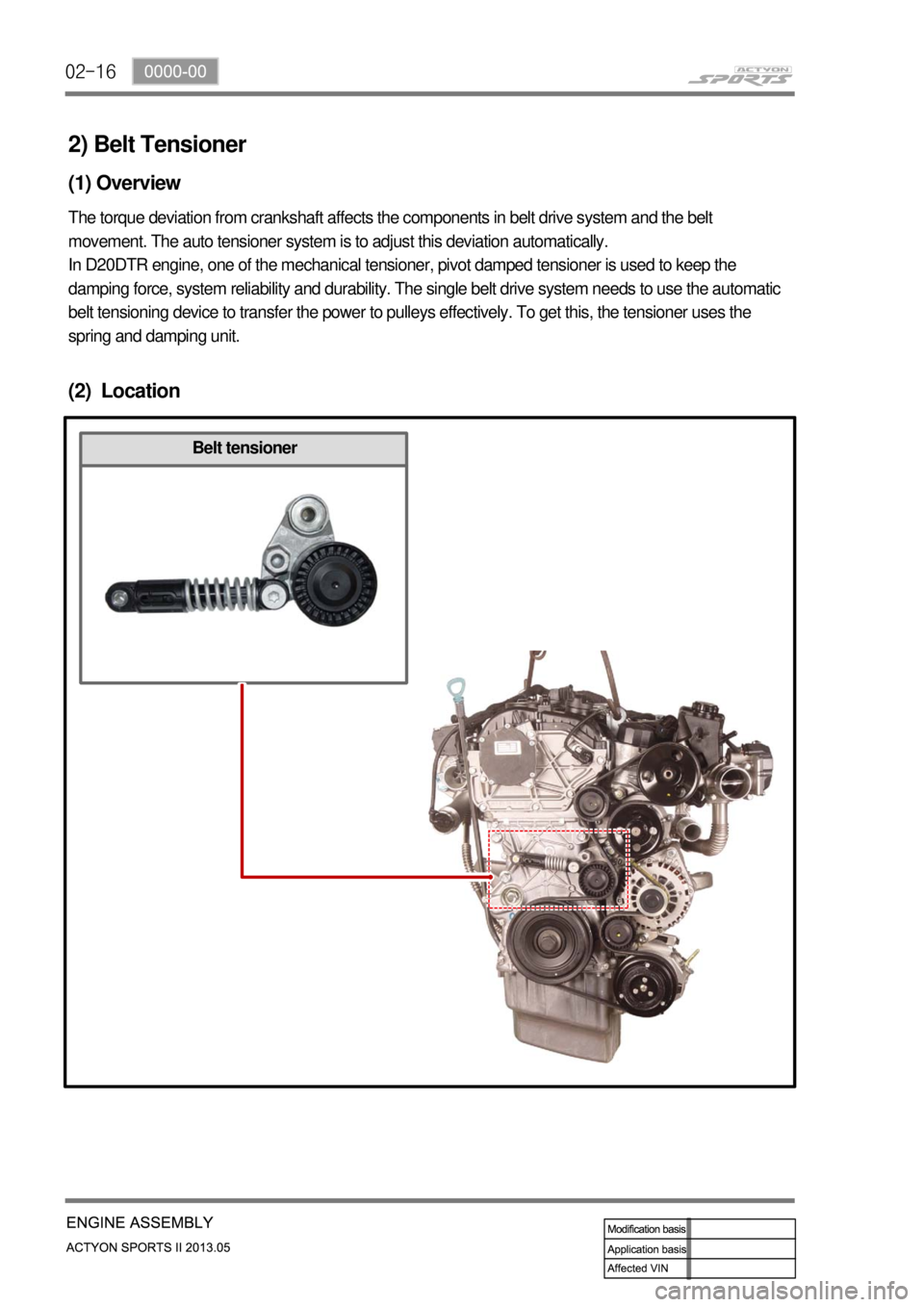
02-16
2) Belt Tensioner
(1) Overview
The torque deviation from crankshaft affects the components in belt drive system and the belt
movement. The auto tensioner system is to adjust this deviation automatically.
In D20DTR engine, one of the mechanical tensioner, pivot damped tensioner is used to keep the
damping force, system reliability and durability. The single belt drive system needs to use the automatic
belt tensioning device to transfer the power to pulleys effectively. To get this, the tensioner uses the
spring and damping unit.
(2) Location
Belt tensioner
Page 153 of 751
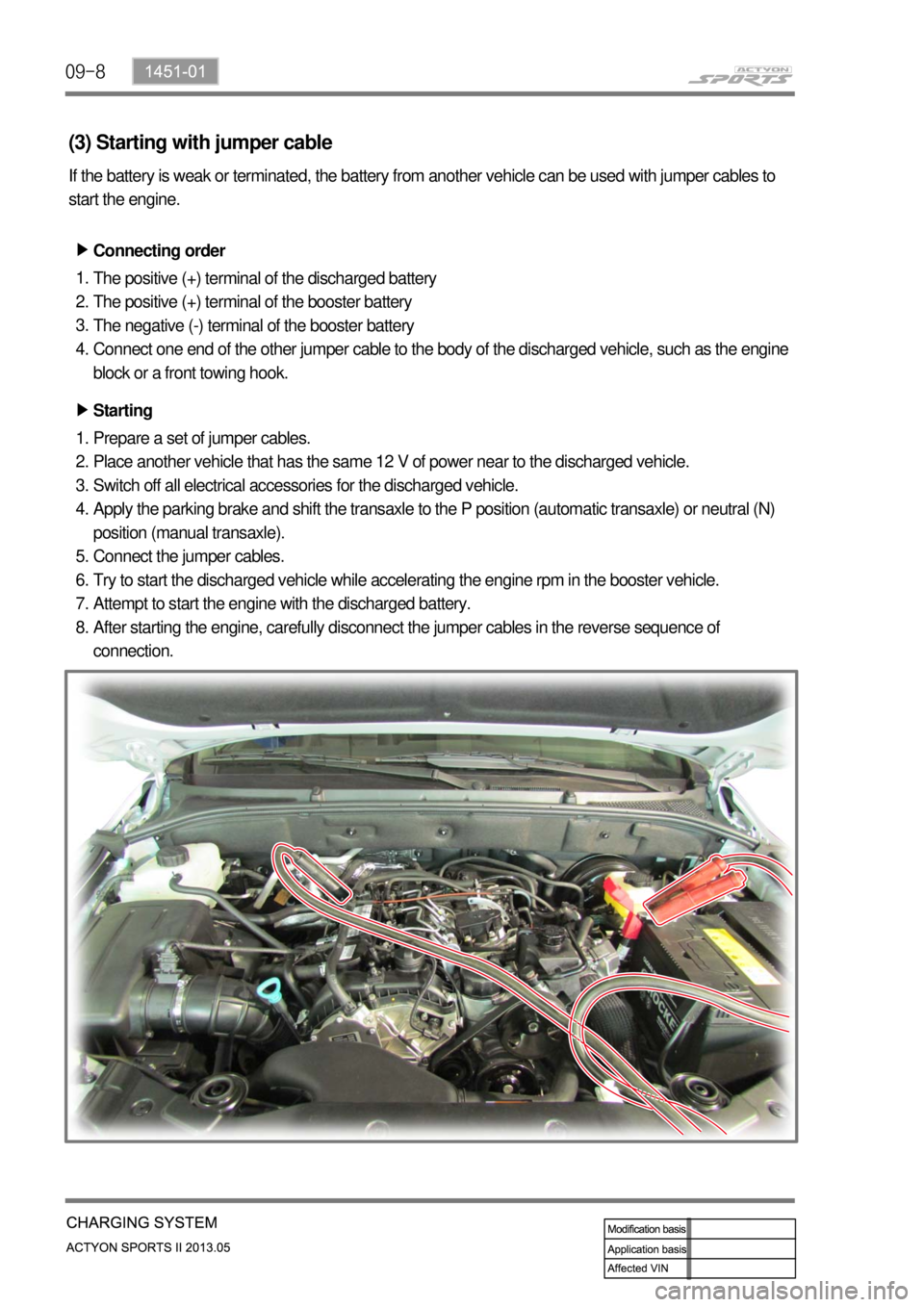
09-8
(3) Starting with jumper cable
If the battery is weak or terminated, the battery from another vehicle can be used with jumper cables to
start the engine.
Connecting order ▶
The positive (+) terminal of the discharged battery
The positive (+) terminal of the booster battery
The negative (-) terminal of the booster battery
Connect one end of the other jumper cable to the body of the discharged vehicle, such as the engine
block or a front towing hook. 1.
2.
3.
4.
Starting ▶
Prepare a set of jumper cables.
Place another vehicle that has the same 12 V of power near to the discharged vehicle.
Switch off all electrical accessories for the discharged vehicle.
Apply the parking brake and shift the transaxle to the P position (automatic transaxle) or neutral (N)
position (manual transaxle).
Connect the jumper cables.
Try to start the discharged vehicle while accelerating the engine rpm in the booster vehicle.
Attempt to start the engine with the discharged battery.
After starting the engine, carefully disconnect the jumper cables in the reverse sequence of
connection. 1.
2.
3.
4.
5.
6.
7.
8.
Page 191 of 751
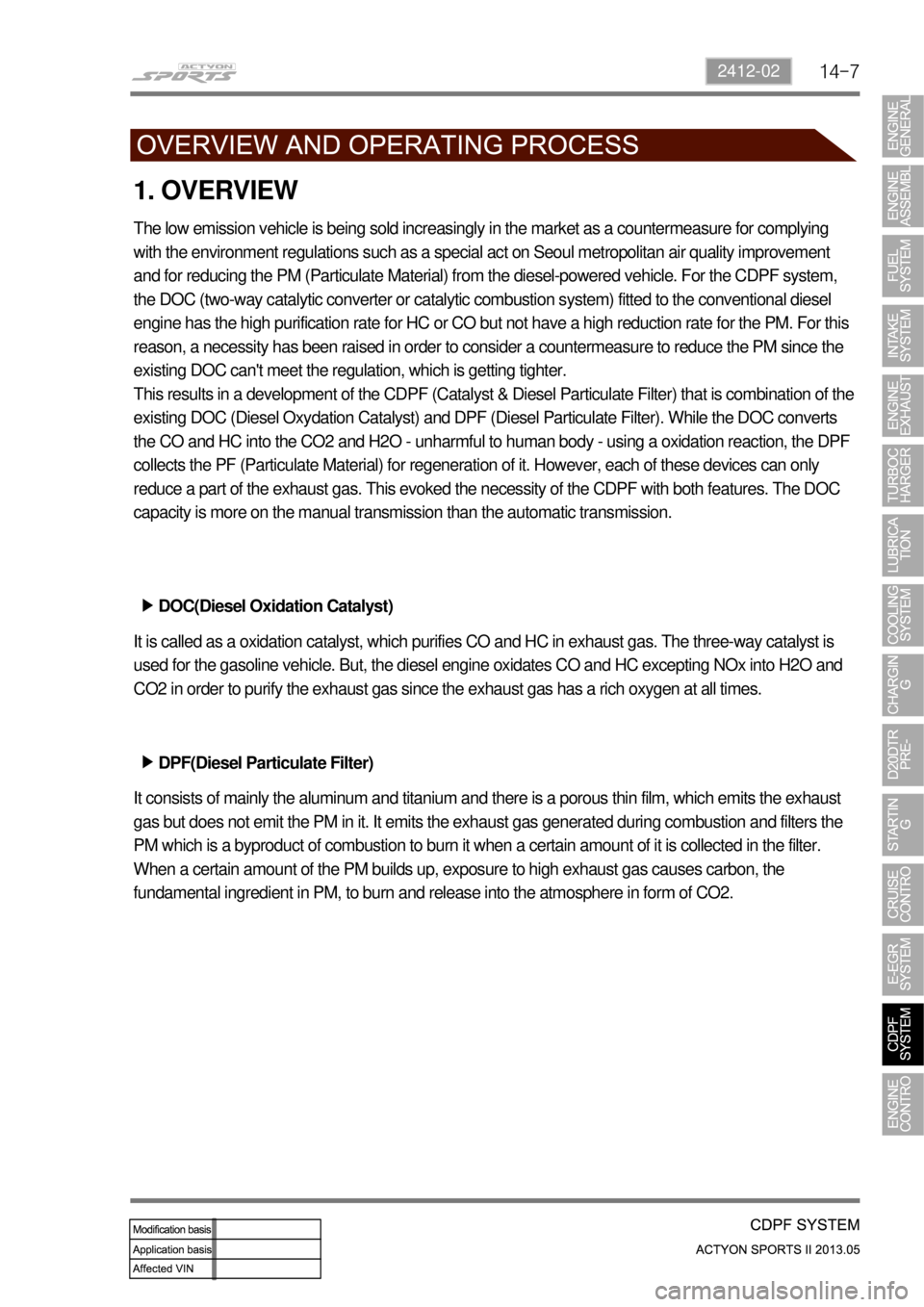
14-72412-02
1. OVERVIEW
The low emission vehicle is being sold increasingly in the market as a countermeasure for complying
with the environment regulations such as a special act on Seoul metropolitan air quality improvement
and for reducing the PM (Particulate Material) from the diesel-powered vehicle. For the CDPF system,
the DOC (two-way catalytic converter or catalytic combustion system) fitted to the conventional diesel
engine has the high purification rate for HC or CO but not have a high reduction rate for the PM. For this
reason, a necessity has been raised in order to consider a countermeasure to reduce the PM since the
existing DOC can't meet the regulation, which is getting tighter.
This results in a development of the CDPF (Catalyst & Diesel Particulate Filter) that is combination of the
existing DOC (Diesel Oxydation Catalyst) and DPF (Diesel Particulate Filter). While the DOC converts
the CO and HC into the CO2 and H2O - unharmful to human body - using a oxidation reaction, the DPF
collects the PF (Particulate Material) for regeneration of it. However, each of these devices can only
reduce a part of the exhaust gas. This evoked the necessity of the CDPF with both features. The DOC
capacity is more on the manual transmission than the automatic transmission.
DPF(Diesel Particulate Filter) ▶DOC(Diesel Oxidation Catalyst) ▶
It is called as a oxidation catalyst, which purifies CO and HC in exhaust gas. The three-way catalyst is
used for the gasoline vehicle. But, the diesel engine oxidates CO and HC excepting NOx into H2O and
CO2 in order to purify the exhaust gas since the exhaust gas has a rich oxygen at all times.
It consists of mainly the aluminum and titanium and there is a porous thin film, which emits the exhaust
gas but does not emit the PM in it. It emits the exhaust gas generated during combustion and filters the
PM which is a byproduct of combustion to burn it when a certain amount of it is collected in the filter.
When a certain amount of the PM builds up, exposure to high exhaust gas causes carbon, the
fundamental ingredient in PM, to burn and release into the atmosphere in form of CO2.
Page 239 of 751
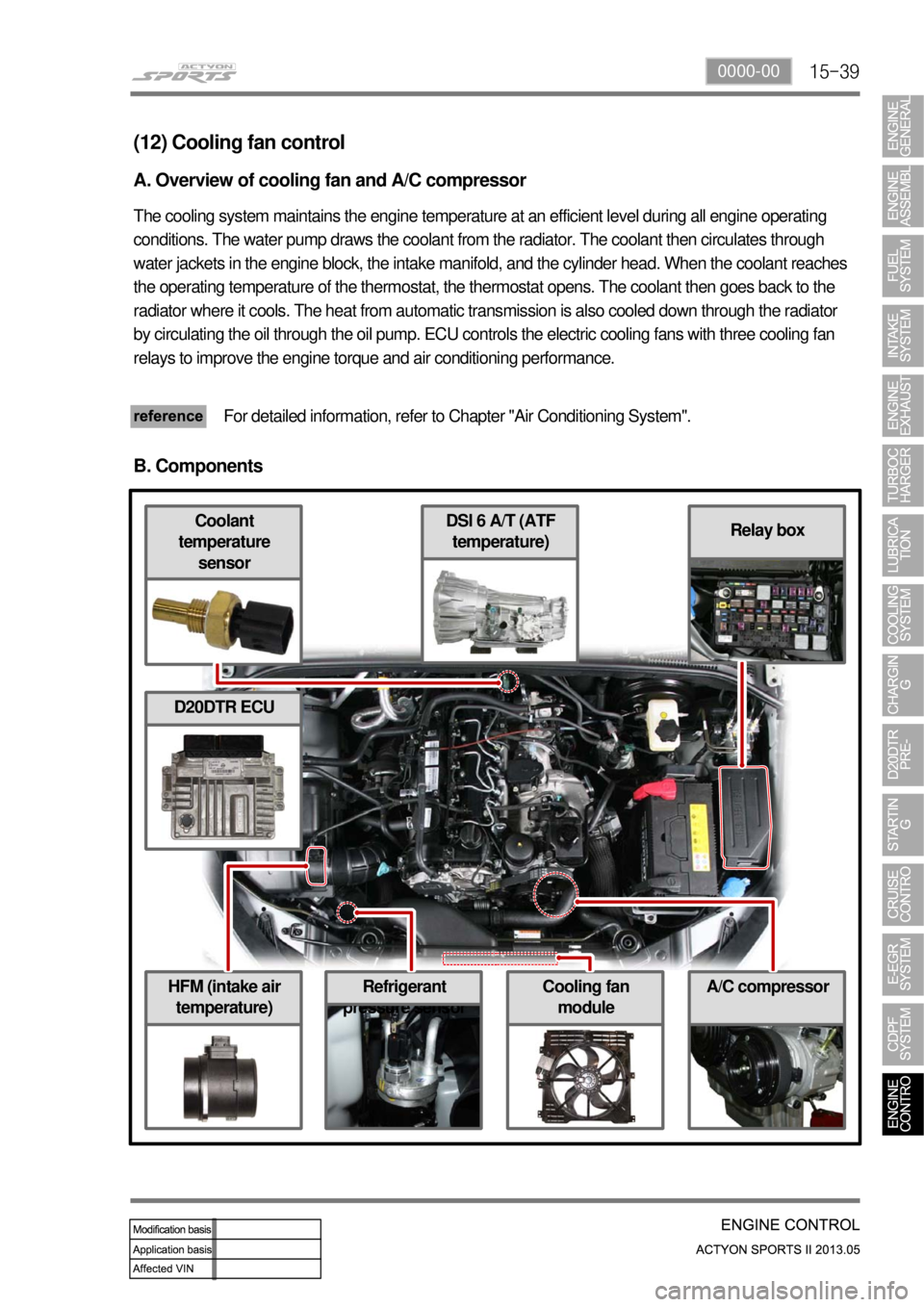
15-390000-00
HFM (intake air
temperature)Cooling fan
module
DSI 6 A/T (ATF
temperature)Coolant
temperature
sensor
Refrigerant
pressure sensor
Relay box
(12) Cooling fan control
A. Overview of cooling fan and A/C compressor
The cooling system maintains the engine temperature at an efficient level during all engine operating
conditions. The water pump draws the coolant from the radiator. The coolant then circulates through
water jackets in the engine block, the intake manifold, and the cylinder head. When the coolant reaches
the operating temperature of the thermostat, the thermostat opens. The coolant then goes back to the
radiator where it cools. The heat from automatic transmission is also cooled down through the radiator
by circulating the oil through the oil pump. ECU controls the electric cooling fans with three cooling fan
relays to improve the engine torque and air conditioning performance.
For detailed information, refer to Chapter "Air Conditioning System".
B. Components
A/C compressor
D20DTR ECU
Page 258 of 751
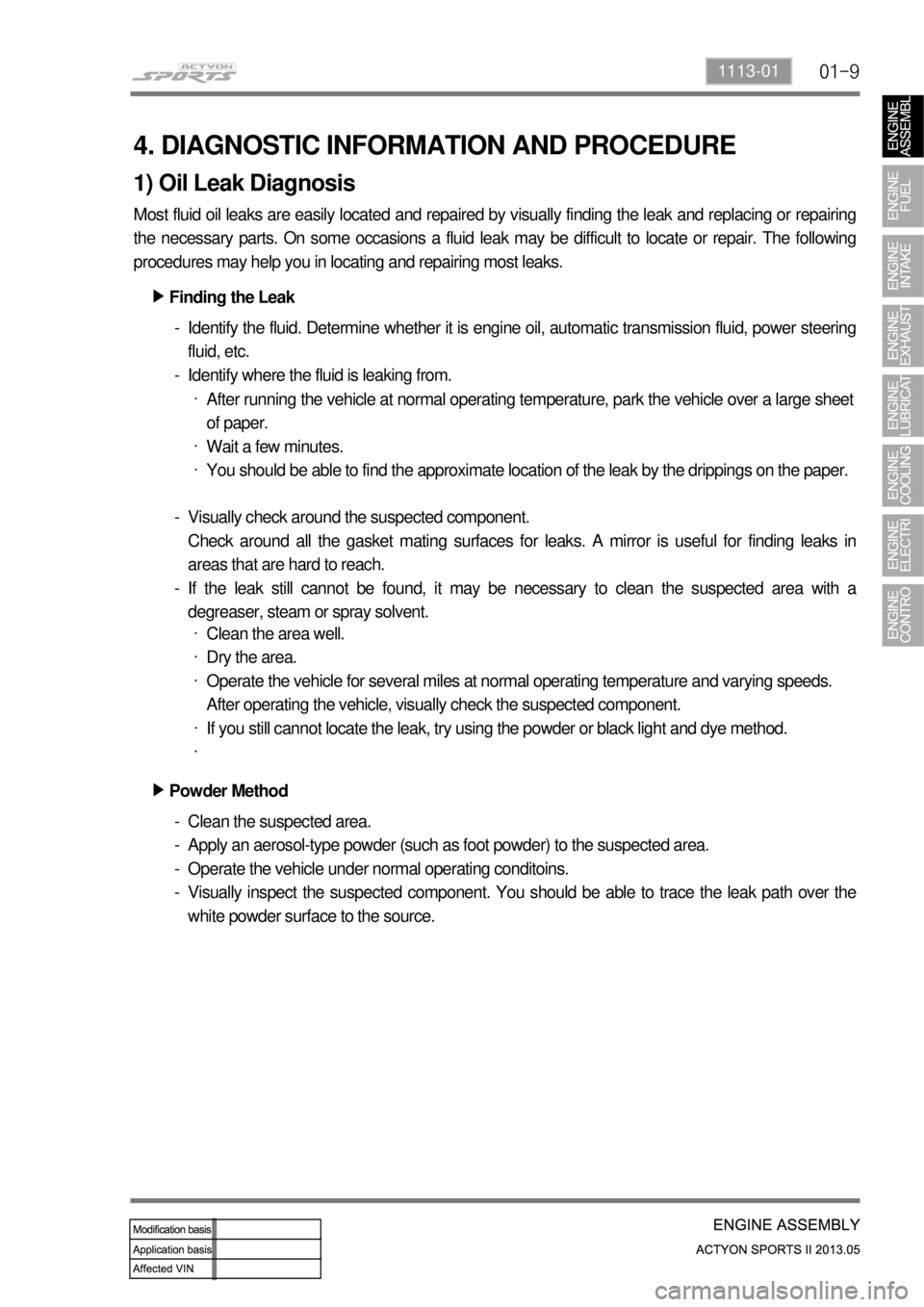
01-91113-01
4. DIAGNOSTIC INFORMATION AND PROCEDURE
1) Oil Leak Diagnosis
Most fluid oil leaks are easily located and repaired by visually finding the leak and replacing or repairing
the necessary parts. On some occasions a fluid leak may be difficult to locate or repair. The following
procedures may help you in locating and repairing most leaks.
Finding the Leak ▶
Identify the fluid. Determine whether it is engine oil, automatic transmission fluid, power steering
fluid, etc.
Identify where the fluid is leaking from. -
-
After running the vehicle at normal operating temperature, park the vehicle over a large sheet
of paper.
Wait a few minutes.
You should be able to find the approximate location of the leak by the drippings on the paper. ·
·
·
Visually check around the suspected component.
Check around all the gasket mating surfaces for leaks. A mirror is useful for finding leaks in
areas that are hard to reach.
If the leak still cannot be found, it may be necessary to clean the suspected area with a
degreaser, steam or spray solvent. -
-
Clean the area well.
Dry the area.
Operate the vehicle for several miles at normal operating temperature and varying speeds.
After operating the vehicle, visually check the suspected component.
If you still cannot locate the leak, try using the powder or black light and dye method. ·
·
·
·
·
Clean the suspected area.
Apply an aerosol-type powder (such as foot powder) to the suspected area.
Operate the vehicle under normal operating conditoins.
Visually inspect the suspected component. You should be able to trace the leak path over the
white powder surface to the source. -
-
-
- Powder Method ▶
Page 286 of 751
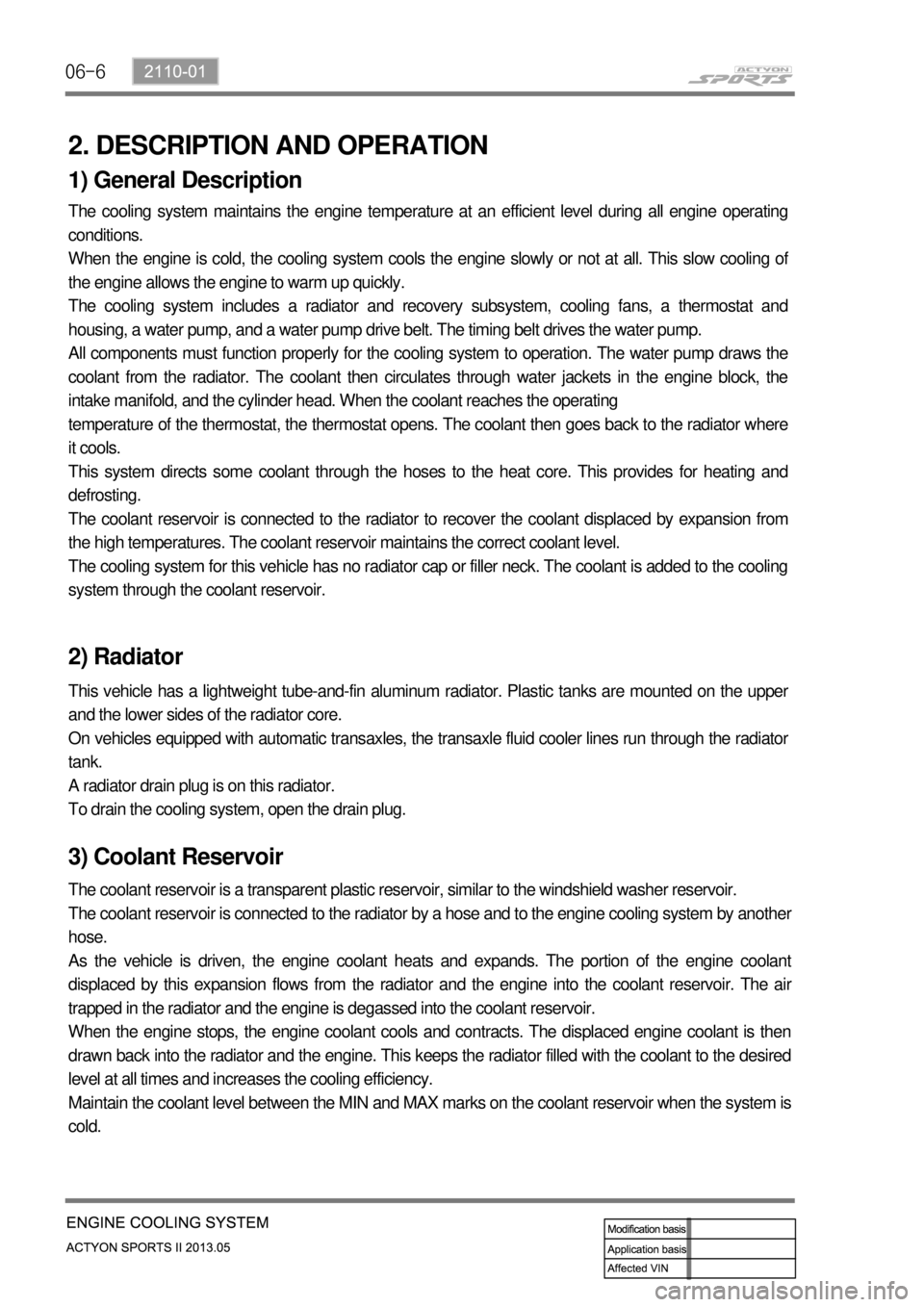
06-6
2. DESCRIPTION AND OPERATION
1) General Description
The cooling system maintains the engine temperature at an efficient level during all engine operating
conditions.
When the engine is cold, the cooling system cools the engine slowly or not at all. This slow cooling o
f
the engine allows the engine to warm up quickly.
The cooling system includes a radiator and recovery subsystem, cooling fans, a thermostat and
housing, a water pump, and a water pump drive belt. The timing belt drives the water pump.
All components must function properly for the cooling system to operation. The water pump draws the
coolant from the radiator. The coolant then circulates through water jackets in the engine block, the
intake manifold, and the cylinder head. When the coolant reaches the operating
temperature of the thermostat, the thermostat opens. The coolant then goes back to the radiator where
it cools.
This system directs some coolant through the hoses to the heat core. This provides for heating and
defrosting.
The coolant reservoir is connected to the radiator to recover the coolant displaced by expansion from
the high temperatures. The coolant reservoir maintains the correct coolant level.
The cooling system for this vehicle has no radiator cap or filler neck. The coolant is added to the cooling
system through the coolant reservoir.
2) Radiator
This vehicle has a lightweight tube-and-fin aluminum radiator. Plastic tanks are mounted on the upper
and the lower sides of the radiator core.
On vehicles equipped with automatic transaxles, the transaxle fluid cooler lines run through the radiato
r
tank.
A radiator drain plug is on this radiator.
To drain the cooling system, open the drain plug.
3) Coolant Reservoir
The coolant reservoir is a transparent plastic reservoir, similar to the windshield washer reservoir.
The coolant reservoir is connected to the radiator by a hose and to the engine cooling system by anothe
r
hose.
As the vehicle is driven, the engine coolant heats and expands. The portion of the engine coolant
displaced by this expansion flows from the radiator and the engine into the coolant reservoir. The ai
r
trapped in the radiator and the engine is degassed into the coolant reservoir.
When the engine stops, the engine coolant cools and contracts. The displaced engine coolant is then
drawn back into the radiator and the engine. This keeps the radiator filled with the coolant to the desired
level at all times and increases the cooling efficiency.
Maintain the coolant level between the MIN and MAX marks on the coolant reservoir when the system is
cold.
Page 297 of 751
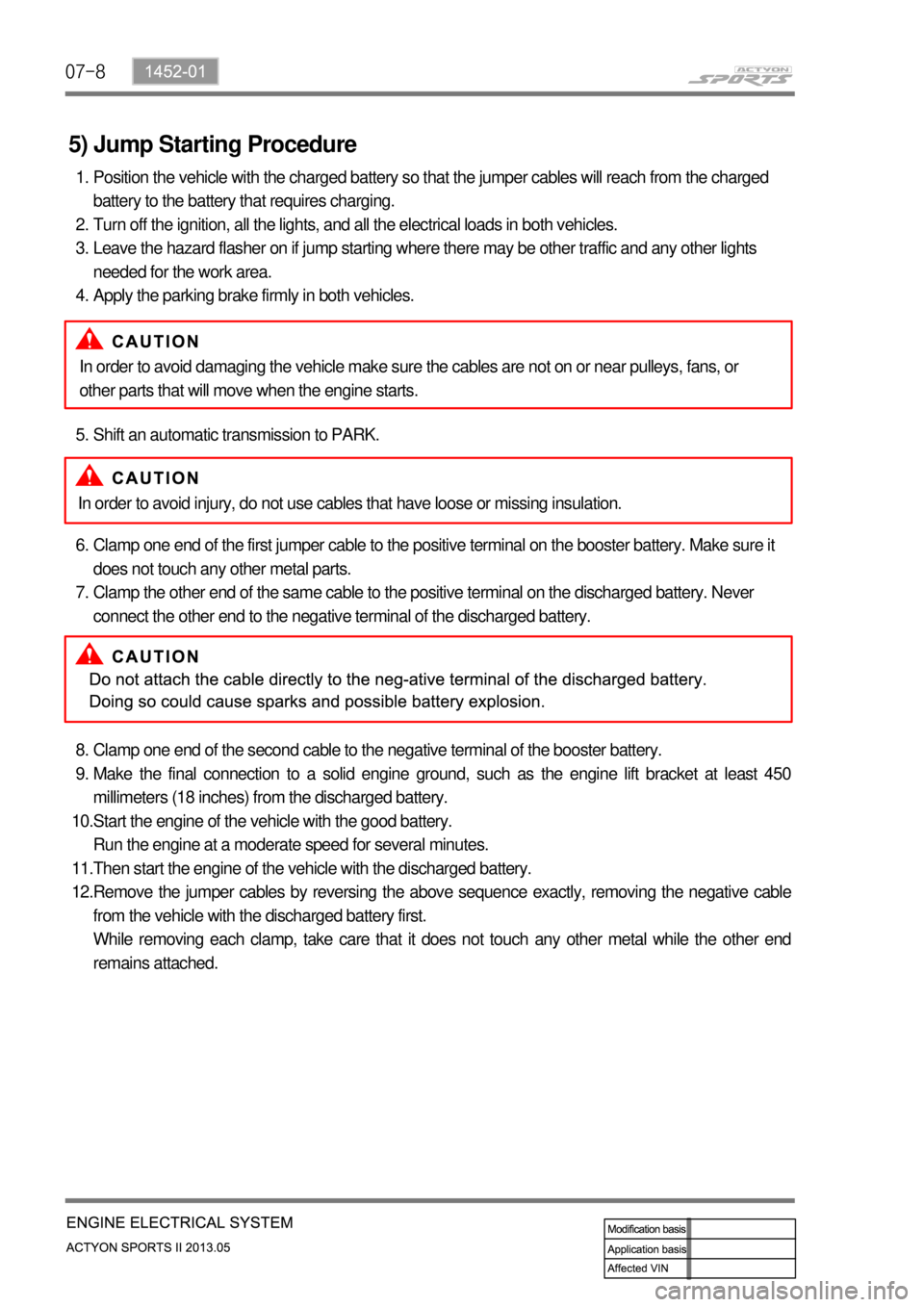
07-8
5) Jump Starting Procedure
Position the vehicle with the charged battery so that the jumper cables will reach from the charged
battery to the battery that requires charging.
Turn off the ignition, all the lights, and all the electrical loads in both vehicles.
Leave the hazard flasher on if jump starting where there may be other traffic and any other lights
needed for the work area.
Apply the parking brake firmly in both vehicles. 1.
2.
3.
4.
Shift an automatic transmission to PARK. 5.
Clamp one end of the first jumper cable to the positive terminal on the booster battery. Make sure it
does not touch any other metal parts.
Clamp the other end of the same cable to the positive terminal on the discharged battery. Never
connect the other end to the negative terminal of the discharged battery. 6.
7.
Clamp one end of the second cable to the negative terminal of the booster battery.
Make the final connection to a solid engine ground, such as the engine lift bracket at least 450
millimeters (18 inches) from the discharged battery.
Start the engine of the vehicle with the good battery.
Run the engine at a moderate speed for several minutes.
Then start the engine of the vehicle with the discharged battery.
Remove the jumper cables by reversing the above sequence exactly, removing the negative cable
from the vehicle with the discharged battery first.
While removing each clamp, take care that it does not touch any other metal while the other end
remains attached. 8.
9.
10.
11.
12.In order to avoid damaging the vehicle make sure the cables are not on or near pulleys, fans, or
other parts that will move when the engine starts.
In order to avoid injury, do not use cables that have loose or missing insulation.
Page 323 of 751

02-138710-01
Rain sensing unit
(AUTO light integrated type)
▶INT Switch Auto Position Remi nder (Power-Up Reminder Wiper)
When turning off and on the auto INT switch, the system drives the wiper motor through LOW
relay regardless of communication with rain sensor.
When turning the INT-AUTO switch from the "OFF" to "ON" position with the ignition switch in the
"ON" mode, the LOW relay operates to drive the wiper motor for 1 cycle, regar\
dless of the rain
sensor communication.
After that, when turning the INT-AUTO switch fr om the "OFF" to "ON" position, the LOW relay
operates to drive the wiper motor for 1 cycle only if data from the rain\
sensor indicates rain drops.
-
-
Multifunction wiper switch:
AUTO and sensitivity control
A sensor that emits infrared rays through LED and
then detects the amount of rain drops by receiving
reflected rays against sensing section (rain senso
r
mounting section on the windshield) with
photodiode (auto light sensor integrated type) AUTO
: Wiper operates automatically by rain sensor
FAST↔SLOW : Auto delay/Auto speed control. A
position that can control sensitivity against rains on
the windshield and transmits wiping demand signal
accordingly
Page 404 of 751
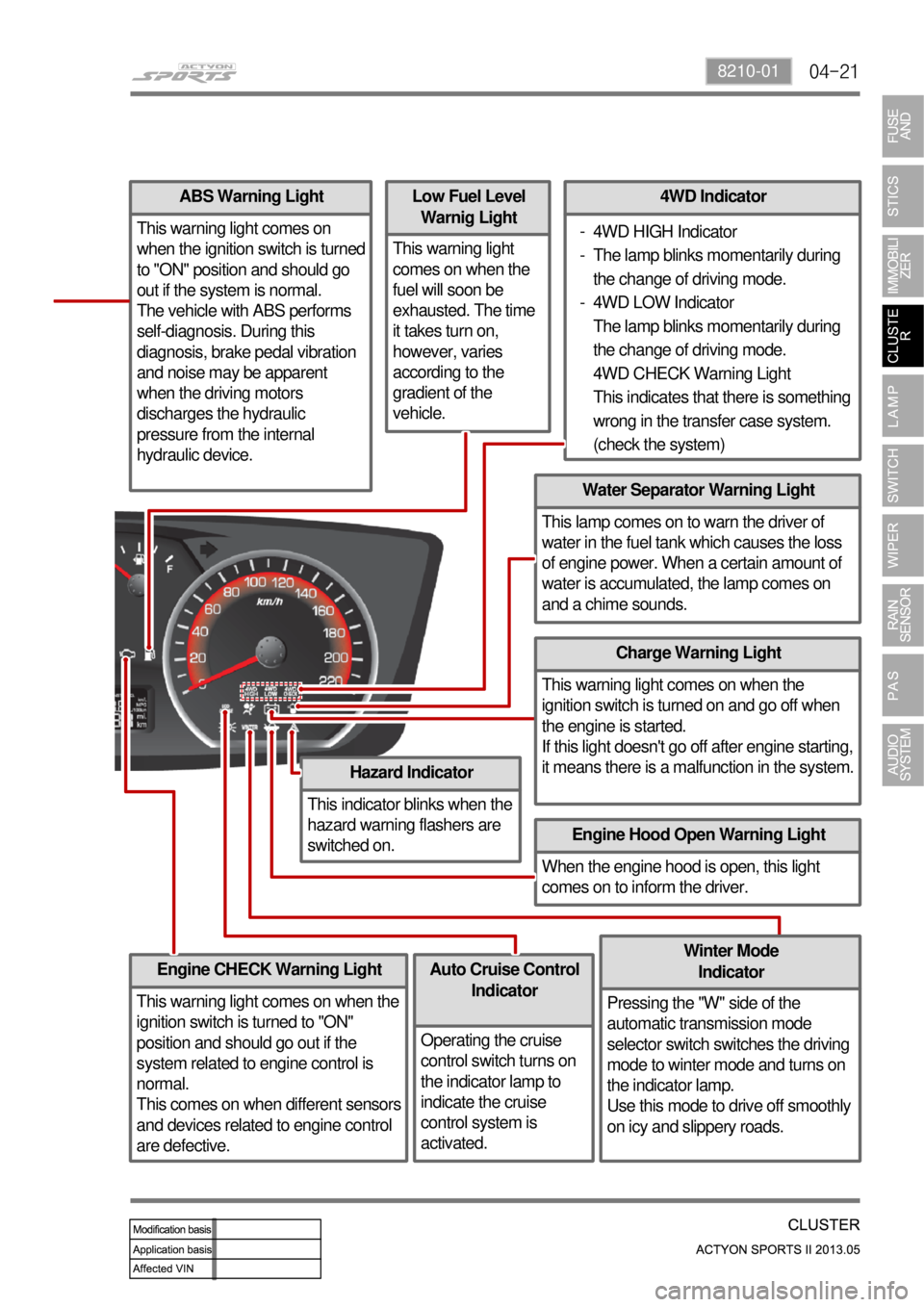
04-218210-01
ABS Warning Light
This warning light comes on
when the ignition switch is turned
to "ON" position and should go
out if the system is normal.
The vehicle with ABS performs
self-diagnosis. During this
diagnosis, brake pedal vibration
and noise may be apparent
when the driving motors
discharges the hydraulic
pressure from the internal
hydraulic device.4WD IndicatorLow Fuel Level
Warnig Light
This warning light
comes on when the
fuel will soon be
exhausted. The time
it takes turn on,
however, varies
according to the
gradient of the
vehicle.
4WD HIGH Indicator
The lamp blinks momentarily during
the change of driving mode.
4WD LOW Indicator
The lamp blinks momentarily during
the change of driving mode.
4WD CHECK Warning Light
This indicates that there is something
wrong in the transfer case system.
(check the system) -
-
-
Auto Cruise Control
Indicator
Operating the cruise
control switch turns on
the indicator lamp to
indicate the cruise
control system is
activated.
Water Separator Warning Light
This lamp comes on to warn the driver of
water in the fuel tank which causes the loss
of engine power. When a certain amount of
water is accumulated, the lamp comes on
and a chime sounds.
Engine CHECK Warning Light
This warning light comes on when the
ignition switch is turned to "ON"
position and should go out if the
system related to engine control is
normal.
This comes on when different sensors
and devices related to engine control
are defective.
Winter Mode
Indicator
Pressing the "W" side of the
automatic transmission mode
selector switch switches the driving
mode to winter mode and turns on
the indicator lamp.
Use this mode to drive off smoothly
on icy and slippery roads.
Charge Warning Light
This warning light comes on when the
ignition switch is turned on and go off when
the engine is started.
If this light doesn't go off after engine starting,
it means there is a malfunction in the system.
Engine Hood Open Warning Light
When the engine hood is open, this light
comes on to inform the driver.
Hazard Indicator
This indicator blinks when the
hazard warning flashers are
switched on.
Page 420 of 751
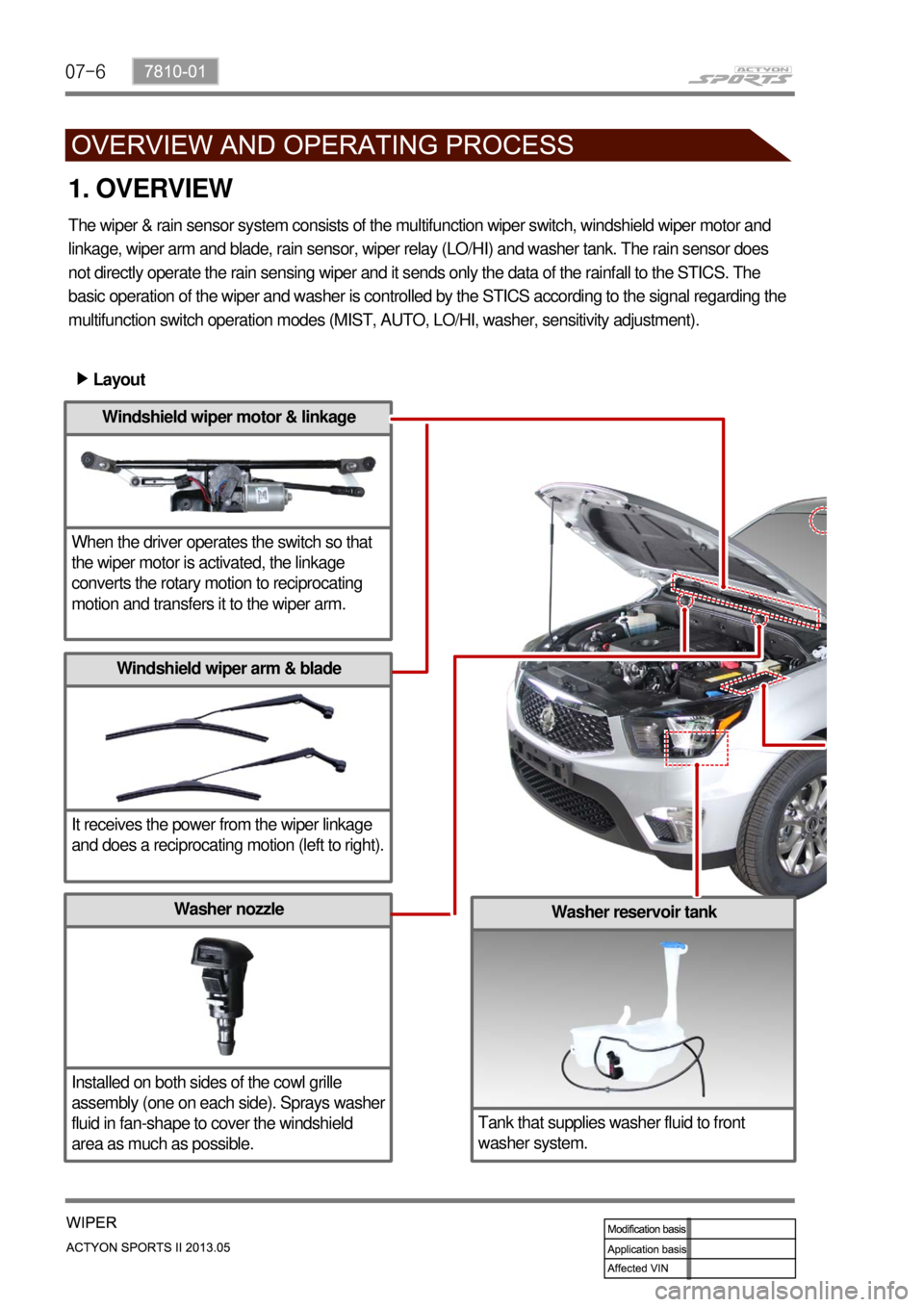
07-6
1. OVERVIEW
The wiper & rain sensor system consists of the multifunction wiper switch, windshield wiper motor and
linkage, wiper arm and blade, rain sensor, wiper relay (LO/HI) and washer tank. The rain sensor does
not directly operate the rain sensing wiper and it sends only the data of the rainfall to the STICS. The
basic operation of the wiper and washer is controlled by the STICS according to the signal regarding the
multifunction switch operation modes (MIST, AUTO, LO/HI, washer, sensitivity adjustment).
Layout ▶
Windshield wiper motor & linkage
When the driver operates the switch so that
the wiper motor is activated, the linkage
converts the rotary motion to reciprocating
motion and transfers it to the wiper arm.
Windshield wiper arm & blade
It receives the power from the wiper linkage
and does a reciprocating motion (left to right).
Washer nozzle
Installed on both sides of the cowl grille
assembly (one on each side). Sprays washer
fluid in fan-shape to cover the windshield
area as much as possible.Washer reservoir tank
Tank that supplies washer fluid to front
washer system.